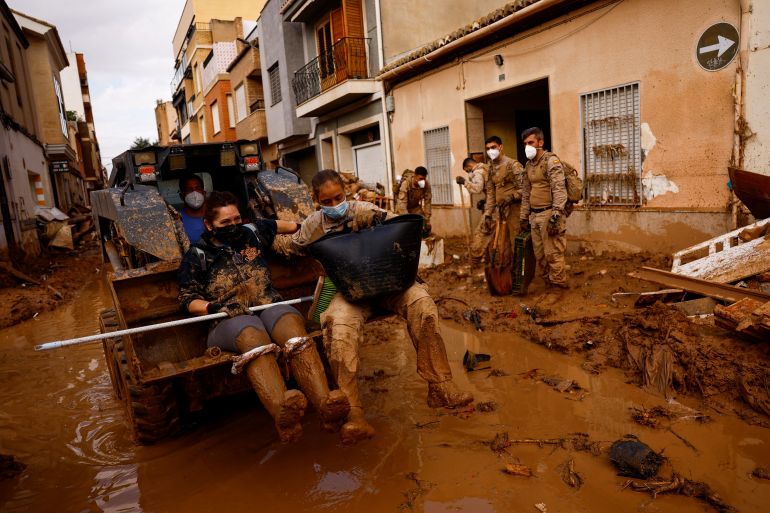What to know about flash floods that killed over 200 people in Spain
Thousands of soldiers deployed as rescue and search operations are under way in the wake of the country’s deadliest disaster in living memory.
A resident near Valencia and a member of the Spanish military were transported in an excavator on a street covered in mud in the aftermath of floods caused by heavy rains [Susana Vera/Reuters]Published On 3 Nov 20243 Nov 2024
Five days after terrifying floods razed towns in eastern Spain and killed at least 214 people, frustration at the government’s response is mounting, even as Prime Minister Pedro Sanchez promised to “improve” recovery efforts with the deployment of 10,000 soldiers and police officers.
Authorities in the hard-hit province of Valencia said on Sunday that hopes of finding more survivors are fading after torrents of muddy water wrecked towns and infrastructure, killing at least 211 people in the region, along with two others in Castilla La Mancha and one in Andalusia.
Al Jazeera’s Sonia Gallego, reporting from Valencia, said authorities fear that more bodies could be recovered from underground garages.
The tragedy is already Europe’s worst flood-related disaster since 1967 when at least 500 people died in Portugal.
Spain’s King Felipe VI and Queen Letizia were due to visit the Valencia region on Sunday, Spanish media reported.
Here’s what to know about Spain’s deadliest disaster in living memory:
What has the state response been?
Management of the crisis, classified as level two on a scale of three by the Valencian government, is in the hands of the regional authorities, who can ask the central government for help in mobilising resources.
At the request of Valencia’s president, Carlos Mazon, of the conservative Popular Party, Socialist Prime Minister Sanchez announced on Saturday the deployment of 5,000 additional soldiers to join rescue efforts, clear debris and provide water and food.
The government would also send 5,000 more national police officers to the region, Sanchez said.
Mazon came under fire over his decision last year to eliminate the Valencia Emergency Unit (UVE), created by a left-leaning predecessor to respond to emergencies like floods and wildfires.
Some 2,000 soldiers from the Military Emergency Unit, the army’s first intervention force for natural disasters and humanitarian crises, are already involved in the emergency work along with about 2,500 Civil Guard personnel and 1,800 national police officers, who have jointly rescued 4,500 people.
Thousands of volunteers from different neighbourhoods also arrived to help, carrying brooms, shovels, water and basic foods, to deliver supplies and help clean up the worst-affected areas.
Al Jazeera’s Gallego said there’s still an “enormous community effort” to help those affected by the floodings, while authorities are “working as quickly as they can” to rescue the survivors.
“Everywhere in town, it is filled with mud,” she said, noting that there are also concerns about the spread of diseases.
What happened?
The storms concentrated over the Magro and Turia river basins and, in the Poyo riverbed, produced walls of water that overflowed riverbanks, catching people unawares as they went on with their daily lives on Tuesday evening and early on Wednesday.
Spain’s national weather service said in the hard-hit Chiva area, it rained more in eight hours than it had in the preceding 20 months, calling the deluge “extraordinary”.
When authorities sent alerts to mobile phones warning of the seriousness of the flooding and asking people to stay at home, many were already on the road, working or covered in water in low-lying areas or underground garages, which became death traps.
What caused these massive flash floods?
Scientists trying to explain what caused the calamity see two likely connections to human-caused climate change.
One is that warmer air holds and then dumps more rain. The other is possible changes in the jet stream – the river of air above land that moves weather systems across the globe – that spawn extreme weather.
Climate scientists and meteorologists said the immediate cause of the flooding is called a “cut-off lower pressure storm system” that migrated from an unusually wavy and stalled jet stream. That system remained parked over the region and poured rain. According to meteorologists, this happens often, and is called DANA, the Spanish acronym for the system.
Damaged cars are buried partially in a ravine after flash floods in Valencia [Manuel Bruque/EPA]
Another factor was the unusually high temperature of the Mediterranean Sea. It had its warmest surface temperature on record in mid-August, at 28.47 degrees Celsius (83.25 degrees Fahrenheit), said Carola Koenig of the Centre for Flood Risk and Resilience at Brunel University of London.
The high temperature increases the capacity to create water vapour, which results in more intense rain.
The extreme weather event came after Spain battled with prolonged droughts in 2022 and 2023.
Experts say that drought and flood cycles are increasing with climate change.
Has this happened before?
Spain’s Mediterranean coast is used to autumn storms that can cause flooding, but this episode was the most powerful flash flood event in recent memory.
Older people in Paiporta, at the epicentre of the tragedy, said Tuesday’s floods were three times as bad as those in 1957, which caused at least 81 deaths.
That episode led to the diversion of the Turia watercourse, which meant that a large part of the town was spared of these floods.
Valencia suffered two other major DANAs in the 1980s, one in 1982 with about 30 deaths, and another five years later that broke rainfall records.
The latest flash floods also surpassed the devastation of the flood that swept away a campsite along the Gallego river in Biescas, in the northeast, killing 87 people, in August 1996.
